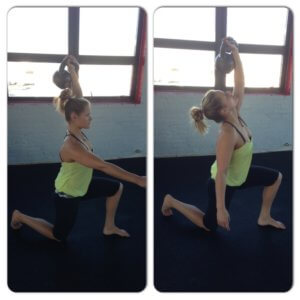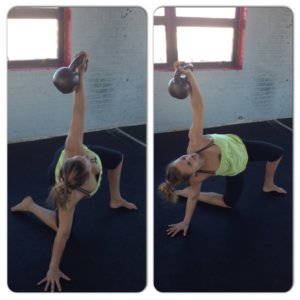-guest post written for Chad Smith and Juggernaut Training Systems!
The Turkish Get Up is by far the most intricate of all the kettlebell lifts. Many will argue that it is the most complex lift around, seeing as it requires the entire body to work together in order to complete. It also happens to be my favorite.
Whether you are a newbie or a seasoned athlete the get up is comprised of many steps and the mastery of the TGU does not happen overnight. I have been “get uping” for years and I am still a work in progress.
Benefits of learning and practicing the Turkish Get Up:
-improved shoulder and hip mobility
-improved shoulder and hip stability
– development of true core strength and stability
– increased shoulder range of motion (shoulder rehab)
– increased grip strength
– strong and solid shoulders
– improved ability to overhead press
– increased coordination
-improved posture
Whether you are a power lifter, yogi, fighter, bodybuilder, strongman, or runner, the TGU can help YOU!
*How you incorporate this lift to your program will depend on your goals and current training regimen.
There are a few different ways to perform the Turkish Get Up out there. My preference is the “hardstyle” get up with 3 point bridge and it is what I will be demoing.
As a beginner I suggest that you perfect the “naked get up” first before moving on to using a weight. This ensures proper shoulder packing as well as postioning for when the kettlebell is introduced.
Maintaining proper shoulder position throughout the 7 steps of the get up can prove difficult for clients with limited shoulder MOBILITY as well as those with shoulder STABILITY issues. For these folks the kettlebell arm bar is an awesome set up exercise for the Turkish Get Up.
The top 5 mistakes I see with beginners and the TGU are…
1) Broken Wrist
Remember to grip the handle HARD.
2) Lack of shoulder packing
Try to feel your shoulder blade lie flat on the floor keeping shoulder away from ear.
3) Splaying of ribcage in the half kneeling position and driving off back leg to stand.
Instead, utilize the core to maintain a tall spine and drive through the front heel.
4) Arching into the low back on the way back down.
Your hand placement should allow the leg to move freely underneath your hips.
5) Loss of shoulder pack/straining the neck to look up at the bell in the standing position.
Remember to keep tight through the core and keep your eyes on the bell at all times EXCEPT from ½ kneeling to standing position.
Almost every one of my clients will utilize SOME part of the TGU within their program. If they aren’t performing the entire Turkish Get Up because of some limitation you bet they are:
-overhead pressing in the half kneeling position
-performing the first three steps of the get up to the high bridge for reps
-completing overhead waiters walks for time
After all, gaining shoulder, hip and core stability as well as t-spine and hip extension are all highly coveted advantages of learning this lift. It’s also fun to show off your strength with some heavy get ups every now and then!
Enough of me, here’s one of my clients performing the Turkish Get Up







